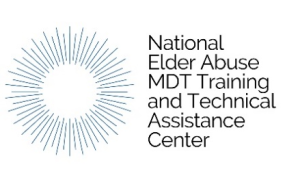National EA MDT TTA Center

E-MDT Hybrid Facilitation Videos
The New York State Elder Abuse Interventions and Enhanced Multidisciplinary Team Initiative and the National Elder Abuse Multidisciplinary Team Training and Technical Assistance Center are pleased to present this series of four videos to guide Enhanced Multidisciplinary Team (E-MDT) Coordinators in navigating issues that may arise during a hybrid E-MDT meeting, where both virtual and in-person participants are present.
Why This Video Series?
The pandemic of 2020 created an additional impetus for E-MDTs to run virtually. In so doing, many E-MDTs found benefits to the remote meeting format, not least of which is the ability to allow participants from more remote locations and participants with tight schedules whose ability to travel for meetings is more limited to participate in these virtual meetings. For these reasons, many E-MDTs continue to provide some form of remote access for E-MDT meetings. At the same time, many E-MDTs are gearing up to provide more in-person meeting formats, to build stronger relationships and trust across E-MDT members as they discuss complex elder abuse cases. As more and more teams seek to strike a balance between in-person and virtual meetings, the hybrid format (which provides both in-person and virtual formats for members) has increasingly gained more interest and traction. However, it is not without its challenges. This video series addresses the challenges of facilitating hybrid E-MDT meetings and ways to optimize the format.
How To View and Utilize These Videos
While we recognize that each team has different components and may operate differently, we hope that the coverage of examples and techniques provides some guidance for how you can implement some of these best practices in a team’s model.
These videos have been created to be viewed as a whole or issue-specific. If you are interested in viewing all the videos, we would recommend watching the videos in the sequence listed below. If there are distinct issues you are interested in pursuing, you may decide to view the relevant video. We encourage you to read the resource document accompanying the Hybrid Facilitation Series videos, which set out the critical tips featured in each video.
What is Covered in This Video Series?
1) Coordinator's Perspective
The “Coordinators’ Perspectives” video discusses the key differences between in-person and hybrid meetings. Presented in interview format, it features two (2) experienced E-MDT coordinators who speak to the unique elements of a hybrid E-MDT meeting format and ways to prepare for and facilitate such meetings relative to in-person meetings.
(Running time: 6:13)
2) Hybrid Meeting Facilitation
The “Hybrid Meeting Facilitation” video utilizes a mock meeting demonstration to showcase the critical areas of effective facilitation of hybrid E-MDT meetings. This video covers how to facilitate complex issues that may arise during a hybrid meeting and demonstrates valuable techniques to keep the case flow productive.
(Running time: 9:48)
Reference Document: Practices to Optimize a Hybrid E-MDT Meeting Flow and Facilitation
3) Confidentiality for Hybrid Meetings
The “Confidentiality for Hybrid Meetings” video discusses confidentiality concerns that may arise during hybrid E-MDT meetings. Confidentiality can be challenging to navigate, especially in a virtual space; this video offers suggested techniques for preventing and managing breaches that may arise in meetings. The video also displays what needs to be established by a team prior to a meeting in a virtual space.
(Running time: 6:23)
Reference Document: Practices to Protect Confidentiality at E-MDT Meetings
4) Facilitating through Technology
The “Facilitating through Technology” video discusses technical considerations when facilitating hybrid E-MDT meetings. This video covers facilitating technical issues that may arise during a hybrid meeting. The video also provides tools to consider embedding in team procedures prior to meetings and procedures to utilize during team meetings.
(Running time: 14:03)
Reference Document: Practices to Leverage Technology for Optimal Participation at E-MDT Meetings
Acknowledgments
We want to thank those who assisted in developing the video series content, namely Allison Granata and Lindsay Calamia of Lifespan of Greater Rochester and Grace Cheong and Khi-Lynn Louis of Weill-Cornell Medicine/New York City Elder Abuse Center. We would also like to thank all video participants: Anna Stetzel, Art Mason, Dianna Leach, Elisabeth Ferner, Lisa Furr, Martie Washington, and Victoria Ybanez. Finally, we thank our program funders; the New York State Office for the Aging, the New York State Office of Victim Services, and The United States Department of Justice/Office for Victims of Crime.
National EA MDT TTA Center
This document was produced by the National Elder Abuse Multi-Disciplinary Team Training and Technical Assistance Center cooperative agreement number 2019-MU-GX-K037, awarded by the Office for Victims of Crime, Office of Justice Programs, U.S. Department of Justice. Additional funding for this document and video was provided by the New York State Office for the Aging and New York State Office of Victim Services and Lifespan of Greater Rochester. The opinions, findings, results, conclusions, interpretations of data, and/or recommendations expressed in this product are those of the contributors and do not necessarily represent the opinions, interpretations, or official position or policies of the U.S. Department of Justice or the State of New York.

